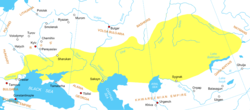Desht-i Qipchaq
| Cuman-Kipchak Confederation | ||||||||||||
| Desht-i Qipchaq | ||||||||||||
| Khanate | ||||||||||||
|
||||||||||||
|
Cumania (Desht-i Qipchaq) c. 1200.
|
||||||||||||
| Capital | Not specified | |||||||||||
| Languages |
Turkic language (Kipchak) |
|||||||||||
| Religion | Tengrism | |||||||||||
| Political structure | Khanate | |||||||||||
| History | ||||||||||||
| • | Established | 10th century | ||||||||||
| • | Disestablished | 1241 | ||||||||||
|
||||||||||||
in Anatolia
Artuqid dynasty
Saltuqid dynasty
in Azerbaijan
Ahmadili dynasty
Ildenizid dynasty
in Egypt
Tulunid dynasty
Ikhshidid dynasty
in Fars
Salghurid dynasty
in The Levant
Burid dynasty
Zengid dynasty
in Yemen
Rasulid dynasty
The name Cumania originated as the Latin exonym for the Cuman-Kipchak confederation, which was a Turkic confederation in the western part of the Eurasian Steppe, between the 10th and 13th centuries. The confederation was dominated by two Turkic nomadic tribes: the Cumans (also known as the Polovtsians or Folban) and the Kipchaks. Cumania was known in Islamic sources as Desht-i Qipchaq, which means "Steppe of the Kipchaks"; or "foreign land sheltering the Kipchaks", in the Turkic languages. Russian sources have referred to Cumania as the "Polovtsian Steppe" (Poloveckaja Step), or the "Polovcian Plain" (Pole Poloveckoe).
The Golden Horde was also referred to as "Comania" by Armenian chronicler Hethum (Hayton) of Korykos. "Cumania" was also the source of names, or alternate names, for several smaller areas – some of them unconnected geographically to the area of the federation – in which Cumans and/or Kipchaks settled, such as the historic region of Kunság in Hungary, and the former Roman Catholic Diocese of Cumania (in Romania and Hungary). Hethum of Korykos described Cumania as "wholly flat and with no trees".Ibn Batutta said of Cumania, "This wilderness is green and grassy with no trees, nor hills, high or low...there is no means of travelling in this desert except in wagons." Battuta's contemporary, Hamdallah Mustawfi, eloborated, "This is of the Sixth Clime, its plains bear excellent pasturage...but there are here few houses or towns or villages. Most of the inhabitants are nomads of the plain...Most of the lands here are swamps...The pasturage, however, being excellent, horses and cattle are numerous, and the population for the most part subsists on the produce thereof. The climate is cold, and their water comes from springs and wells."
...
Wikipedia

